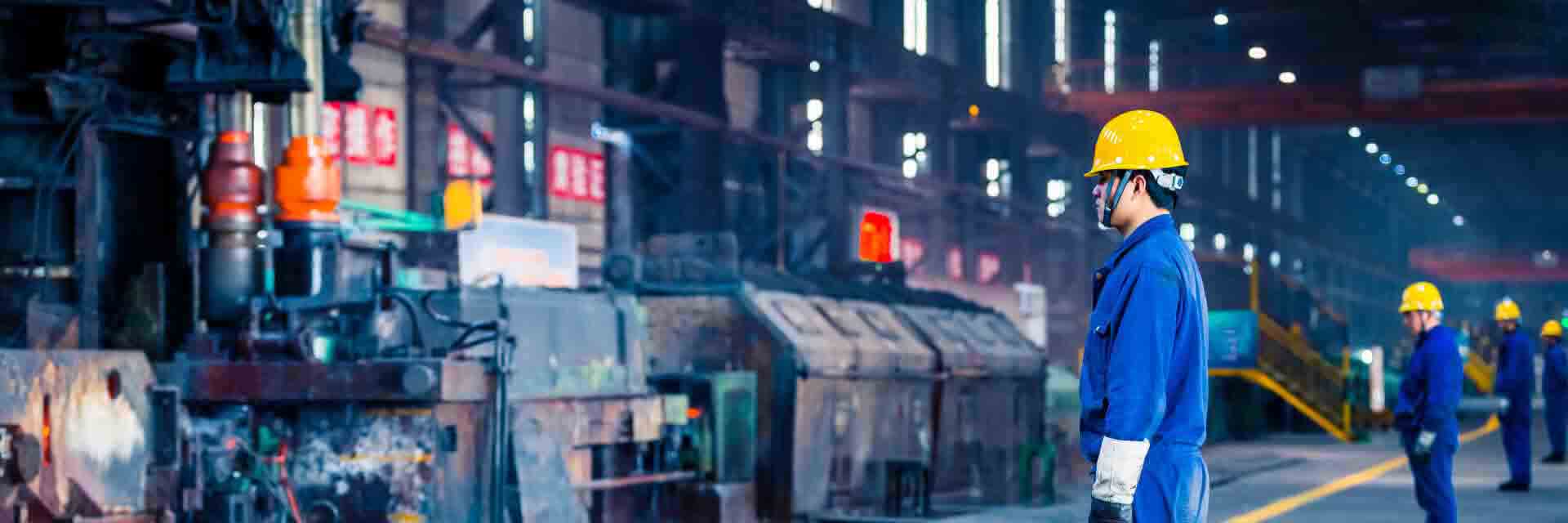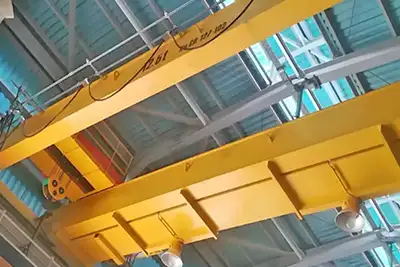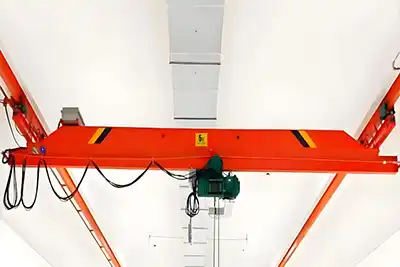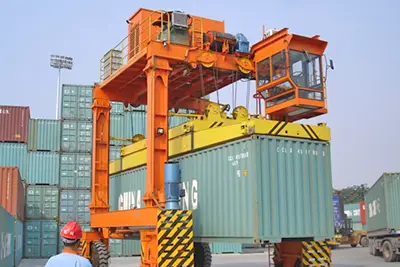Overhead Crane Safety for Chemical Plant Buyers, Exproof Crane
Choose the right overhead crane for chemical plants—focus on safety, explosion-proof features, corrosion resistance, and expert customization for optimal performance.
Overview of Overhead Cranes in the Chemical Industry and Related Sectors
Overhead cranes play a vital role in the chemical industry and its related sectors.
They are used to lift, move, and position heavy loads in areas where human handling would be unsafe or impossible.
Chemical plants deal with a wide range of equipment and materials. Some are bulky, fragile, highly corrosive, or even dangerous to touch.
In these environments, overhead cranes offer a clean and efficient solution.
Common sectors where overhead cranes are essential include:
- Basic chemical manufacturing, like acids, solvents, and polymers
- Petrochemical plants and oil refineries
- Specialty chemical production, such as adhesives and coatings
- Agrochemical facilities making fertilizers and pesticides
- Pharmaceutical factories producing active drug ingredients
- Industrial gas plants handling high-pressure gases
- Water treatment and recycling centers using strong chemicals
Each of these industries has different needs, but they all share one thing: the need for safe, reliable lifting equipment built for tough conditions.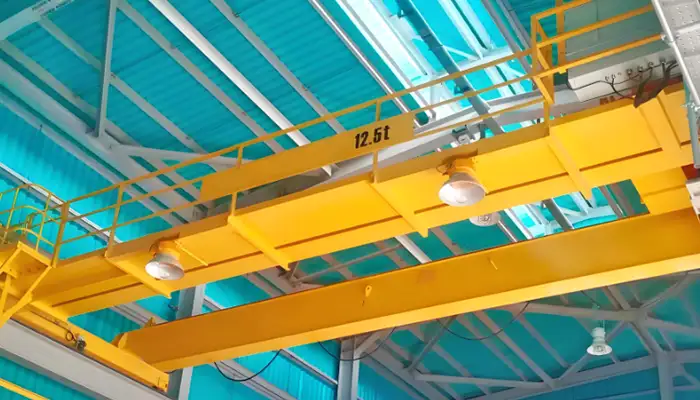
European style explosion proof overhead crane for sale
Why Specialized Crane Safety Is Crucial When Handling Hazardous, Corrosive, or Sensitive Materials
Handling chemicals is never simple.
Many of the materials moved inside a plant can catch fire, explode, or release harmful fumes if something goes wrong.
Cranes in chemical plants must be built with extra care because:
- Ordinary cranes can spark, causing explosions in flammable areas
- Metal surfaces can corrode fast in chemical vapors, weakening the crane
- Electrical components can fail if not sealed against gases and dust
- Mishandling sensitive or fragile loads can cause serious accidents or expensive damage
In short, it's not just about lifting heavy things. It's about lifting safely in places where mistakes can have huge consequences.A specialized overhead crane can handle harsh conditions, protect workers, and keep production running smoothly. Without the right design, though, a crane can quickly become the plant’s biggest safety risk.
Purpose of This Guide
Buying an overhead crane for a chemical plant is not like buying one for a simple warehouse.
There are more risks, more regulations, and more technical details to get right.
The purpose of this guide is to:
- Help buyers understand the unique risks when operating cranes in chemical and hazardous environments
- Explain what technical requirements are critical for safety, durability, and performance
- Guide buyers through the selection process so they choose a crane that fits both their application and safety needs
If you are responsible for sourcing cranes for a chemical or related plant, this guide will give you a clear, practical foundation before you make your decision.
Chemical Industry and Related Industrial Sectors
Key Sectors That Depend on Overhead Cranes
Overhead cranes are not just used in heavy industries like steel and mining.
In chemical and related sectors, they are just as important — sometimes even more so.
Here are some of the main industries where overhead cranes are critical:
- Basic Chemical Manufacturing
Plants making acids, alkalis, solvents, and other base chemicals often use cranes to move large tanks, drums, and heavy processing units.
These materials can be highly reactive or corrosive, so cranes need strong protection. - Petrochemical and Refinery Plants
Cranes help lift and position equipment for processing crude oil into fuels and chemical products.
In these zones, there’s a high risk of fire and explosion, so cranes must often be explosion-proof. - Specialty Chemical Production
This includes manufacturing adhesives, coatings, pigments, and sealants.
Loads can range from sensitive containers to large mixers and reactors.
Handling must be precise to avoid damaging valuable or delicate materials. - Pharmaceutical Manufacturing
Cranes are used to lift bulk drug ingredients, fermentation vessels, and sensitive biological materials.
Cleanliness and contamination control are top priorities here, so cranes often need special finishes and enclosed designs. - Agrochemical Industry
Fertilizer and pesticide plants move raw materials and finished products that can be dusty, corrosive, or even toxic.
Dust-proof and corrosion-resistant cranes are often necessary. - Industrial Gases
Plants producing oxygen, nitrogen, hydrogen, and other gases require cranes to lift heavy gas cylinders, tanks, and machinery.
Many of these environments have strict explosion-proof requirements. - Water Treatment and Chemical Recycling Facilities
These plants use chemicals like chlorine and ozone for water purification.
Cranes must resist corrosion from constant exposure to chemicals and moisture.
Each of these sectors deals with different challenges. But they all share a need for cranes that are tough, safe, and built for specialized conditions.
How Crane Safety and Specifications Vary Depending on the Chemical and Process Environment
Not all chemical plants are the same.
And not all overhead cranes can handle every chemical environment.
Cranes must be carefully selected based on:
- Type of Hazardous Material
Some chemicals are flammable. Some are highly corrosive. Some are both.
If there's a risk of explosion, cranes must have certified explosion-proof motors, brakes, and electrical systems. - Exposure to Corrosive Vapors or Liquids
Standard steel parts can rust and weaken fast.
In these cases, cranes should be made with stainless steel components, coated surfaces, or specially protected wiring. - Cleanroom or Contamination-Sensitive Areas
In pharmaceutical or specialty chemical plants, even tiny amounts of contamination can ruin products.
Here, cranes need smooth finishes, sealed parts, and easy-to-clean surfaces. - Operating Temperature and Humidity
Some chemical processes happen at extreme temperatures or high humidity levels.
Cranes must be designed to perform reliably without electrical failure or mechanical wear. - Duty Cycle and Usage Intensity
Some plants use cranes occasionally for maintenance.
Others use them every day for production.
Heavy-use environments need cranes with higher duty ratings and extra durability.
In short, no two chemical plants need exactly the same crane. It’s critical to match the crane's design, material, and safety features to the specific risks and environment of the plant.
Typical Loads Handled and Load Handling Applications
Common Types of Loads
In chemical plants and related sectors, overhead cranes move a wide variety of loads.
Some are bulky and heavy. Others are delicate or even dangerous to handle.
Here are some of the most common types:
- Bulk Chemical Containers (IBCs, Drums, Totes)
These containers are filled with raw materials or finished chemical products.
They need careful handling to avoid spills, leaks, or contamination. - Process Equipment (Heat Exchangers, Reactors, Filtration Units)
Big pieces of equipment like reactors and filters are often lifted during installation, repair, or replacement.
These loads can be very heavy and awkwardly shaped. - Structural Components (Piping, Tanks, Pressure Vessels)
Large tanks, pipe systems, and vessels are part of building or expanding chemical plants.
Cranes must be strong and stable to handle these loads safely. - Maintenance and Repair Items (Motors, Valves, Pumps)
Regular maintenance work often requires lifting motors, pumps, and valves out of tight spaces.
Precision and control are especially important in these cases. - Fragile or Hazardous Materials (Glass-Lined Reactors, Catalyst Beds)
Some materials are both extremely valuable and easy to damage.
A small mistake when lifting could cost a fortune or create a safety hazard.
In every case, cranes must be reliable, smooth-operating, and properly suited to the type of load.
Typical Applications
Overhead cranes in chemical plants aren't just for big construction jobs.
They are part of daily operations too.
Some common crane applications include:
- Loading and Unloading of Chemical Raw Materials
Cranes help move heavy containers off trucks or railcars and into storage or processing areas.
Speed and safety are key, especially when handling dangerous materials. - Installation and Maintenance of Plant Machinery
When new machines are installed or old ones are serviced, cranes do the heavy lifting.
They also help position equipment exactly where it needs to go. - Shutdown Turnarounds Requiring Heavy Lifting Under Tight Safety Controls
During plant shutdowns for maintenance or upgrades, cranes often work in tight spaces under strict schedules.
Safety and planning become even more critical during these times. - Movement of Corrosive, Flammable, or High-Value Chemical Products Within Production Areas
Some products must be transferred carefully between stages of production.
Specialized cranes make sure these moves happen without leaks, spills, or damage.
In short, cranes are essential for keeping chemical plants running smoothly — not just during construction, but every single day.
Types of Overhead Cranes Commonly Used in Chemical and Related Industries
Not every overhead crane works for chemical plants. The choice depends on the type of load, the work environment, and the plant layout.
Here are the most common types you’ll find:
Top Running Double Girder Overhead CranesThese are the heavy lifters.
They move along rails mounted on top of the runway beams.
They offer high lifting capacities and can handle very large, heavy equipment like reactors and pressure vessels.
Good choice for busy production halls needing frequent and heavy lifting.
Top Running Single Girder Cranes
These cranes are lighter and simpler.
They are great for moving lighter loads like pumps, drums, or maintenance parts.
They also cost less and are easier to maintain.
Good when you need flexibility without super heavy lifting.
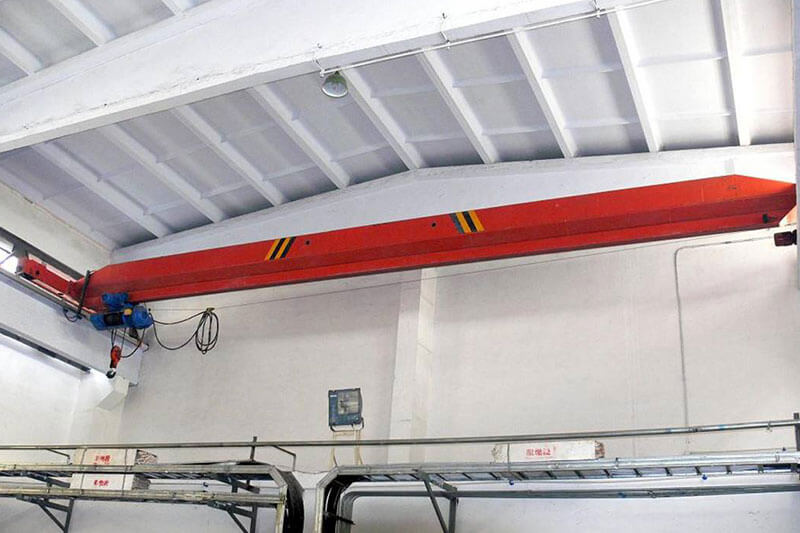
Explosion-Proof Overhead Cranes
In areas with flammable gases, vapors, or dust, safety is non-negotiable.
Explosion-proof cranes use special motors, controls, and wiring to prevent sparks or heat buildup.
Essential for petrochemical plants, gas facilities, and some basic chemical factories.
Corrosion-Resistant Cranes with Stainless Steel or Coated Components
Chemicals can eat away regular steel fast.
These cranes use stainless steel parts or special anti-corrosion coatings to survive harsh environments.
A must for plants handling acids, chlorines, or high-moisture processes.
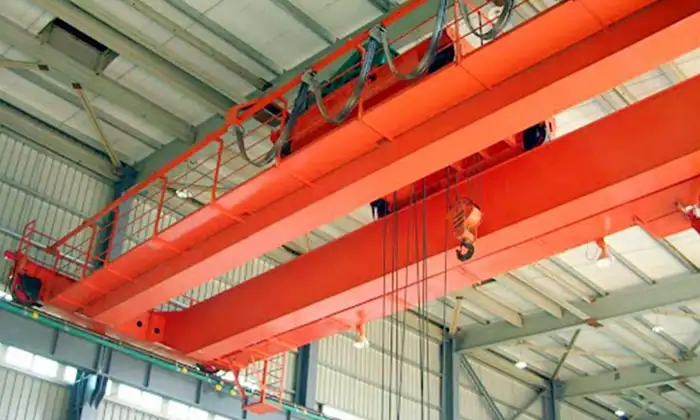
Cleanroom Overhead Cranes for Pharmaceutical and Biotech Sectors
Cleanrooms need cranes that don't shed dust, particles, or oil.
These cranes are built with smooth, sealed surfaces and special lubricants.
They are also easy to clean and resistant to chemical cleaning agents.
Custom-Built Cranes for Highly Confined or Specialized Environments
Some areas are too tight for standard cranes.
In these cases, cranes are designed specifically for the space, the lifting tasks, and the hazards.
Custom cranes can include special dimensions, low-headroom designs, or added safety systems.
Underrunning Cranes for Low-Clearance Building Layouts
These cranes are perfect when ceiling height is a problem.
They run on the bottom flange of a runway beam.
They are lighter and great for lighter loads and tight, low-clearance areas often found in smaller processing rooms or chemical storage zones.
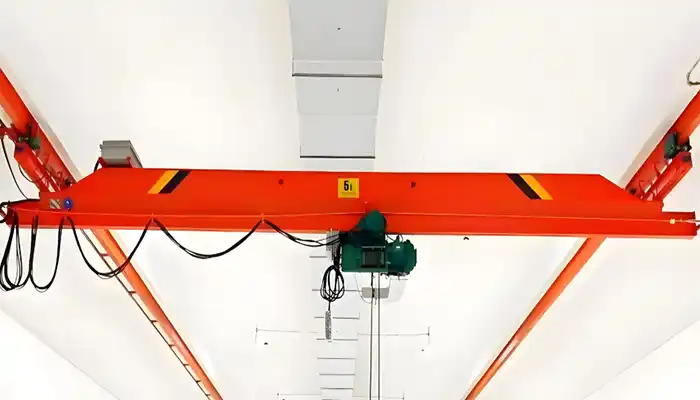
Hazards and Risk Factors When Using Overhead Cranes in Chemical Environments
Working with overhead cranes in chemical plants is not simple. The environment itself adds many risks that must be managed carefully.
Here are the main hazards to watch for:
- Exposure to Flammable Gases, Vapors, and Dust Leading to Explosion Risks
Many chemical plants handle materials that can ignite easily.
One small spark from crane motors, brakes, or electrical systems could cause a major explosion.
That’s why explosion-proof cranes are often required in classified areas. - Corrosive Damage from Chemical Fumes, Spills, or Spray
Chemicals like acids and solvents can slowly eat away at crane parts.
Fumes alone, even without direct contact, can cause rust, pitting, or electrical failure over time.
Without the right protective coatings or materials, cranes can become unsafe faster than expected. - High Humidity and Extreme Temperatures Accelerating Equipment Wear
Some chemical processes create very humid or high-heat environments.
Moisture can get into motors, wiring, and bearings.
Extreme heat or cold can also crack or weaken materials.
Special seals, enclosures, and heat-resistant components help cranes survive longer in these conditions. - Risk of Contamination for Sensitive Production Areas (Pharmaceutical, Specialty Chemicals)
In clean production environments, even tiny particles or grease can ruin a batch of product.
Overhead cranes in these areas must be built to avoid shedding dust, oils, or debris.
Surfaces must be easy to clean and designed to meet strict hygiene standards. - Increased Risk During Heavy Load Handling in Confined or Classified Hazardous Zones
Tight spaces make crane operations harder and more dangerous.
Loads swinging or snagging on structures can cause spills, fires, or mechanical failure.
Operators need cranes with smooth controls, accurate positioning, and extra safety features like load limiters and anti-sway systems.
Essential Safety Features to Demand for Chemical Industry Cranes
When buying a crane for a chemical plant, safety features are not just optional — they are critical. Here’s what you should always look for:
Explosion-Proof Designs
Handling flammable gases and vapors requires cranes that can’t ignite anything — even under fault conditions.
Important points:
- Motors, electrical cabinets, brakes, and limit switches must be fully rated for hazardous areas.
- Look for cranes built to ATEX or IECEx standards, depending on your local regulations.
- Explosion-proof cranes prevent sparks, high heat, and electrical arcs.
Without this, you’re risking serious accidents in hazardous zones.
Corrosion-Resistant Materials
Chemicals attack steel and metal parts fast.
If a crane rusts or weakens, it becomes unsafe.
To protect against corrosion:
- Use cranes with stainless steel wire ropes or chains.
- Look for galvanized or specially coated steel frames that resist chemical damage.
- Make sure all bolts, nuts, and hardware are non-corrosive.
This keeps your crane reliable even after years of chemical exposure.
Fully Enclosed Electrical Systems
In chemical plants, dust and vapors can sneak into everything — including electrical parts.
That’s why fully sealed systems are necessary.
What to look for:
- Dust-proof and vapor-proof enclosures around all switches, controls, and panels.
- Sealed connectors and gaskets that prevent internal contamination.
- Electrical panels rated for the environment, like IP65, IP66, or better.
It’s a small detail that prevents big failures.
Specialized Overload Protection Systems
Chemical loads are often heavy and fragile at the same time.
Overloading can damage products, equipment, and the crane itself.
Good safety systems include:
- Automatic load monitoring to alert or shut down if weight limits are exceeded.
- Emergency lowering systems that safely bring loads down if something fails.
- Anti-sway control to keep loads from swinging dangerously during moves.
These systems protect workers, products, and the crane investment.
Redundant Safety Systems Where Required
In critical operations, a backup plan is not a luxury — it’s a must.
Key backups to require:
- Dual braking systems so that if one brake fails, another takes over instantly.
- Redundant hoist drives in cranes where nonstop operation is crucial.
- Emergency stop systems that are easy to access and fast to activate.
Redundancy adds a layer of security when the stakes are highest.
Matching Crane Specifications to Environmental and Operational Conditions
Choosing a crane isn’t just about lifting capacity. You also have to match the crane to the real conditions inside your plant.
Hazardous Area Classifications
If your plant has explosive gases or dust, the crane must meet strict standards.
- Zones 1 and 2 are for areas with flammable gases and vapors.
- Zones 21 and 22 are for places where combustible dust is present.
- Cranes for these areas must be built to ATEX or IECEx standards.
- All motors, brakes, and controls must be explosion-proof and certified.
This helps avoid fires and explosions in high-risk zones.
Temperature Considerations
Chemical plants often deal with extreme temperatures.
Some areas are freezing cold, others are extremely hot.
- Cranes operating in cryogenic environments need special low-temperature components.
- High-heat areas require cranes with heat-resistant materials and cooling systems.
- Motors, gearboxes, and brakes must be rated for the full temperature range.
If the crane isn't rated correctly, parts can crack, seize, or fail.
Cleanliness Requirements
In pharmaceuticals or food-related chemical plants, keeping the environment clean is critical.
- Use FDA-grade cleanroom cranes where contamination control is needed.
- These cranes are built with smooth, sealed surfaces that won’t trap dust or bacteria.
- They are easy to clean and can withstand chemical sanitizers.
Without the right crane, you risk ruining batches or facing regulatory issues.
Duty Cycle Needs
Think about how often the crane will operate.
Different applications need different crane strengths.
- Continuous process plants (like big chemical factories) need cranes designed for high-frequency, heavy-duty use.
- Maintenance areas can use lighter-duty cranes since they are operated less often.
- A mismatch here can cause cranes to wear out too fast or cost more than necessary.
Choosing the right duty class ensures you get long, reliable service without overpaying.
Certifications and Compliance Standards
When buying a crane for a chemical plant, it’s essential that the crane meets specific safety standards and regulations.
These certifications help ensure the crane will work safely in hazardous conditions.
Here’s a rundown of the key certifications to look for:
ATEX Certification (EU Requirements for Explosive Atmospheres)
- ATEX stands for Atmosphères Explosibles, a European Union standard for equipment used in explosive environments.
- Cranes must be rated for Zones 1 or 2, which are areas where explosive gases or vapors might be present.
- ATEX certification confirms that the crane is built to minimize risks like sparks or overheating that could cause an explosion.
This certification is crucial for chemical plants handling flammable substances.
IECEx Certification (Global Standard for Explosion Protection)
- IECEx is an international certification system for electrical equipment used in explosive environments.
- Like ATEX, it applies to zones where explosive gases or dust may be present.
- IECEx certification ensures the crane meets the required explosion protection standards, no matter where in the world it’s used.
It’s a global standard that ensures your crane is up to code, wherever you operate.
CE Marking (European Safety Compliance)
- The CE marking is a European symbol that shows a product meets European Union safety, health, and environmental standards.
- It’s required for most equipment sold in Europe, including overhead cranes.
- The CE mark ensures the crane complies with EU regulations, from design to installation.
If you’re in the EU or dealing with EU regulations, this mark is essential.
ISO 9001 and ISO 45001 (Quality Management and Occupational Safety Standards)
- ISO 9001 is the international standard for quality management systems.
- ISO 45001 focuses on occupational health and safety management systems.
- These certifications mean the crane manufacturer follows best practices for quality control and workplace safety.
They show that the crane maker is committed to quality and safety.
OSHA Compliance for Operations in the United States
- In the U.S., cranes must meet OSHA (Occupational Safety and Health Administration) standards.
- OSHA ensures that overhead cranes are safe to use in industrial environments, preventing accidents and injuries.
- Cranes used in the U.S. must also meet specific operational guidelines and inspections for workplace safety.
OSHA compliance is mandatory for safe crane operations in the U.S.
Local Jurisdictional Standards (e.g., NEC, NFPA in North America)
- NEC (National Electrical Code) and NFPA (National Fire Protection Association) set standards for electrical systems and fire safety in the U.S.
- Cranes must be designed to meet these codes in locations where electrical hazards or fire risks are present.
- These standards address electrical wiring, equipment installation, and fire prevention measures.
Always check local regulations to ensure the crane meets all the necessary legal requirements for your area.
Customization Options to Improve Safety and Performance
When you're looking for an overhead crane for a chemical plant, you want it to be as safe and efficient as possible.
Sometimes, off-the-shelf options won’t cut it, especially when you're dealing with hazardous or sensitive environments.
Here are some customization options that can make a real difference in both safety and performance:
Explosion-Proof Wireless Radio Control Systems
In chemical plants, safety is the top priority, especially when it comes to operating cranes in hazardous zones.
- Wireless radio control systems let operators control the crane from a safe distance.
- These systems are essential when you need to avoid being close to potentially dangerous areas, like those with flammable gases or chemicals.
- Explosion-proof wireless controls are specifically designed to work safely in these environments, preventing any electrical interference or sparks that could lead to accidents.
This is a must-have feature for plants dealing with explosive atmospheres.
Anti-Collision and Zoning Systems for Multi-Crane Facilities
If you have more than one crane operating in the same space, things can get tricky.
- Anti-collision systems are designed to prevent cranes from bumping into each other, which reduces the risk of accidents.
- Zoning systems ensure that each crane stays within its own designated area, helping to maintain a safe distance from other equipment or machinery.
These systems are particularly useful in tight spaces where multiple cranes need to work together without interference.
Spark-Resistant Hooks, Wheels, and Components
In chemical environments, sparks can be dangerous, especially when handling flammable materials.
- Spark-resistant components like copper or bronze hooks and wheels reduce the risk of sparking, which can ignite gases or dust.
- Using spark-resistant hooks and wheels ensures that there’s less chance of triggering an explosion or fire when moving loads.
This simple upgrade can go a long way in improving safety in your facility.
Specialized Lifting Attachments
Not all loads are the same, and some materials need extra care.
- Specialized lifting attachments like drum grabs, vacuum lifters, or spreader beams can make handling specific loads much easier and safer.
- These tools are designed to securely lift things like barrels, fragile containers, or even large, awkward items.
- They help improve load stability and prevent damage or accidents, especially with sensitive materials.
This customization ensures that you can handle each type of load with precision and care.
Condition Monitoring Systems to Predict Wear and Prevent Failure
Crane downtime can be costly, and breakdowns are even worse in high-risk environments.
- Condition monitoring systems track the health of critical crane components like motors, brakes, and cables.
- These systems can alert you to early signs of wear, like unusual vibrations or overheating, before they turn into bigger problems.
- Preventing a breakdown in advance can save you time, money, and avoid safety risks.
With a monitoring system, you can keep your crane in top condition without worrying about sudden failures.
Choosing the Right Crane Supplier
When it comes to buying a crane for your chemical plant, choosing the right supplier is just as important as choosing the right crane.
You need a supplier who understands the unique challenges of your industry and can offer reliable, safe solutions.
Here are key factors to keep in mind when selecting a crane supplier:
Experience in Supplying Overhead Cranes for Chemical and Related Industries
You want a supplier with a proven track record in your specific industry.
- Industry experience matters because chemical plants face unique challenges.
- A supplier who has worked with chemical, pharmaceutical, or petrochemical industries will understand the specific safety standards and operational needs.
- They will be familiar with the necessary certifications, like explosion-proof and corrosion-resistant features.
Choosing a supplier with the right experience gives you confidence in the crane’s ability to perform safely and efficiently in your environment.
Ability to Customize Cranes Based on Specific Hazardous Environment Requirements
Every chemical plant is different, so your crane needs to be customized to fit your specific environment.
- Look for a supplier who offers customization options, such as explosion-proof motors, corrosion-resistant materials, and specialized control systems.
- The supplier should be able to tailor cranes to your plant’s hazardous areas, whether it’s for explosive gases, high temperatures, or strict cleanliness requirements.
A one-size-fits-all crane won’t meet the safety or operational demands of a chemical plant. Customization is key.
Proven Record of Delivering Certified Explosion-Proof and Corrosion-Resistant Solutions
Safety is non-negotiable in chemical plants, so the crane supplier must be able to provide certified solutions.
- The supplier should offer cranes that are explosion-proof (ATEX or IECEx certified) for hazardous zones.
- Cranes must also be corrosion-resistant, built with stainless steel or special coatings to withstand harsh chemical environments.
Check if the supplier has a proven track record of delivering reliable, certified solutions that meet international standards.
Strong After-Sales Support, Including Inspections, Preventive Maintenance, and Parts Supply
The right crane is only part of the equation. After installation, you’ll need ongoing support.
- A good supplier should offer strong after-sales support that includes regular inspections and preventive maintenance.
- Ensure they have a readily available parts supply to avoid long downtimes.
- Ask about their service contracts, which might include things like scheduled maintenance or emergency repairs.
This support is essential to keep your crane running smoothly and avoid costly downtime.
Availability of Training Programs for Crane Operators and Maintenance Teams
Even the best crane can’t perform optimally without proper training.
- Check if the supplier offers training programs for both crane operators and maintenance teams.
- The training should cover safe crane operation, emergency procedures, and basic maintenance.
- Well-trained staff help prevent accidents and ensure the crane is properly maintained, extending its lifespan.
A supplier who offers training shows that they care about the long-term success of your operations.
Common Pitfalls to Avoid When Purchasing
Purchasing an overhead crane for a chemical plant is a big investment.
To avoid costly mistakes, it’s important to be aware of common pitfalls that can lead to safety hazards, operational downtime, and increased costs.
Here’s a look at some key mistakes to avoid when making your crane purchase:
Failing to Properly Classify Hazardous Areas Before Specifying the Crane
Hazardous areas in chemical plants require careful planning.
- Don’t skip the hazardous area classification. You need to know exactly where explosive gases, flammable dust, or other dangerous conditions exist.
- If you don’t properly classify these zones, you risk choosing a crane that isn’t suitable for the environment, which could lead to explosion risks or equipment failure.
- Be sure to specify ATEX or IECEx-certified cranes for any areas that have high risks.
Proper classification is the first step in ensuring your crane is safe and compliant with regulations.
Choosing Standard Industrial Cranes Without Necessary Modifications
Chemical plants are not standard industrial environments.
- Standard cranes may not meet the specific needs of your chemical facility, especially when it comes to handling dangerous or sensitive materials.
- If you don’t get the necessary modifications—like explosion-proof motors, corrosion-resistant parts, or specialized control systems—you could be compromising safety.
- Make sure your crane is customized to your plant’s unique operating conditions.
Always ensure that the crane is designed specifically for the hazards and materials you’re dealing with.
Ignoring Corrosion Resistance, Leading to Premature Failure
Corrosion can be a silent enemy in chemical plants.
- Chemical fumes, spills, or humidity can quickly degrade crane components if they’re not built with corrosion-resistant materials.
- Ignoring this aspect can lead to premature failure, safety hazards, and costly repairs.
- Look for cranes made with stainless steel, galvanized components, or special coatings to withstand your plant’s corrosive environment.
Don’t cut corners on corrosion resistance; it’s essential for long-term crane reliability.
Overlooking the Importance of Long-Term Inspection and Maintenance Planning
Buying a crane isn’t a one-time event; it’s an ongoing responsibility.
- Skipping long-term planning for inspection and maintenance is a big mistake.
- Cranes in chemical plants require regular inspections to ensure everything is functioning correctly and safely.
- Failing to plan for preventive maintenance can lead to unexpected downtime or even safety risks.
Work with your crane supplier to set up a solid inspection and maintenance plan that will help keep your crane in top shape.
Inadequate Supplier Verification Regarding Certifications and Field Experience
Not all suppliers are created equal.
- Don’t just take a supplier’s word for it—verify their certifications.
- Ensure that the supplier provides cranes that meet ATEX or IECEx explosion-proof standards and that they have experience with chemical and industrial environments.
- Also, check if the supplier has real-world experience in your specific industry. Experience makes a huge difference when it comes to delivering reliable, compliant cranes.
Always do your research to ensure you’re working with a supplier who can meet the high standards required for chemical plants.
Conclusion
In chemical and related industries, safety is paramount, and your crane system plays a huge role in ensuring that.
- Every overhead crane system must be carefully matched to your plant’s operating environment, the types of loads you handle, and the specific risks you face.
- This means considering factors like explosion-proof requirements, corrosion resistance, and hazardous area classifications before making a decision.
Choosing the right crane supplier is just as important as choosing the right crane itself.
- Partnering with a supplier who understands the complexities of chemical plants will help you get a crane that meets safety standards, fits your specific needs, and can be customized for your facility.
- A supplier who offers certifications, provides long-term support, and understands the importance of regular maintenance can make a significant difference in keeping your plant safe and efficient.
In the end, investing in the right crane and supplier means investing in a safer, more efficient operation for the long term. Don’t take shortcuts when it comes to safety!

